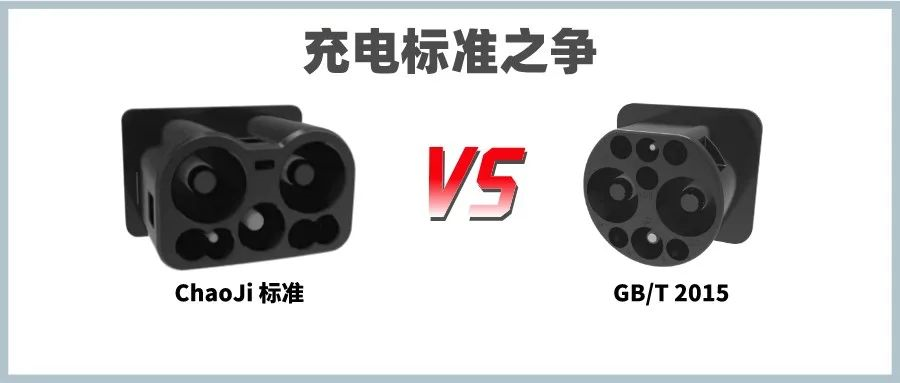The Battle between Two Charging Standards in China’s Automotive Industry
Author | Huang Shan
Editor | Qiu Kaijun
“This may be our only chance to decide which technological route to take for the future, and it’s related to whether the national charging standard can become an international standard, and whether domestic cars can directly enter the global market.”
This was said by a charging regulation personnel from a certain host factory. What choice is so crucial?
It’s the battle between two charging standards that are being revised: one is the upgraded version of the 2015 national charging standard (hereafter referred to as 2015+), and the other is the ChaoJi charging standard.
The 2015 version of the national charging standard has been in effect until today and has become one of the bottlenecks restricting the development of electric vehicles, as it has many problems, such as insufficient mechanical strength of the charging interface, potential safety hazards, lack of support for high power fast charging, and inability to coordinate with global charging standards.
The question is whether to simply amend the existing standards or to completely start over and choose the new ChaoJi standard to solve many problems at once?
Regardless of which one is chosen, it will directly determine the development of the vehicle charging system, the production of connectors, the investment and construction of charging infrastructure, as well as testing and certification, and of course, it will also determine the charging safety and experience of subsequent electric vehicle owners.
The new standard also needs to consider more issues:
- How to make it compatible with the existing nearly 10 million new energy vehicles and over 100,000 public charging stations?
- How long does it take to replace the old and new vehicles and charging piles? How high is the corresponding cost?
- Is there enough space reserved for future upgrades?
- How to connect with international standards? …
The upgrade and revision of the 2015 national standard was led by the China Automotive Technology and Research Center, with input from the host factories, certain charging operators and connector manufacturers as the demand side, and its connectors can be compatible with the existing 2015 national standard, but it has inherent defects.
The ChaoJi charging standard is led by the China Electricity Council, with input from the power grid, charging operators, connector manufacturers, and some car companies as the supply side. This standard is entirely new, and its vehicle sockets need an adapter to connect to the existing GB/T 2015 version charging sockets.
Both standards have their pros and cons, but which one should be chosen?
This dilemma has turned into a state of chaotic competition.
“We really don’t want to be dragged along anymore. We need to quickly make a decision. We’ve voiced our opinions and taken a stance. We can’t make the final decision anyway. Every day of weighing pros and cons is just wasting time,” said a charging regulation personnel from a certain host factory.
Standard-setting has never been easy. Behind it is a battle of interests, positions, and perception, a struggle between tackling easy issues first or difficult issues first, a battle between scientific and technological expertise and leadership authority, and a battle between reality and ideals.
This article aims to bring a relatively comprehensive background, differences, progress, and views from different industry insiders about the two major standard routes.
As such, this article will cover the following topics:## Why new standards are needed
Upgrades mean there were issues with the previous standards.
The current GB/T 2015 national standard for charging is a revised version of the GB/T 2011 national standard, and was officially implemented on January 1, 2016 as an upgraded patch.
The core of GB/T 2015 charging national standard consists of three parts and five standard documents, which are:
- GB/T 18487.1 “Electric vehicle conductive charging system”, which controls the charging pile’s control system and safety.
- GB/T 20234.1/.2/.3 “Connection devices for conductive charging of electric vehicles”, which controls the socket on the vehicle and the gun head on the pile.
- GB/T 27930 “Communication protocol between non-vehicle-mounted conductive charging equipment and battery management system for electric vehicles”, which controls how the vehicles and the piles communicate and issue instructions.
Some of the problems with GB/T 2015 national standards are inherent hardware design issues and some are post-development problems, generally including the following:
-
The direct current interface structure design does not meet the international IPXXB anti-finger protection rating, which means that a person’s fingers can be inserted into the existing national standard vehicle charging socket, leading to a certain safety risk. Because of this, the International Electrotechnical Commission (IEC) standard excludes the entire Chinese direct current charging scheme from European standards, which means that domestic vehicles must comply with local charging standards when exporting, rather than exporting directly based on national standards.
-
There is a large gap tolerance between the charging plug and socket, which can cause shaking and wear during insertion.
-
Two auxiliary power sources in the existing direct current 9-pin connector are becoming more and more superfluous, and more and more models do not require the charging pile to provide auxiliary power.
-
The mechanical strength is not enough, and the gun head is easily damaged. Due to poor working environments, car owners often throw and grind the gun heads, which can cause them to break or deteriorate over time, a problem that has occurred in many charging stations.
-
The locking mechanism has a high failure rate. This is a common problem and can cause accidental locking of the gun, making it difficult to remove, or even not locking at all.
-
When the PE pin of the grounding protection is disconnected, neither the vehicle nor the pile can detect it, posing potential safety risks during charging.
-
The current single CAN communication can cause delays or failures due to a lack of physical switches for blocking.
-
The limit on maximum charging voltage and current cannot meet the demand for high-power charging. In the current GB/T 18487.1-2015, the highest voltage is 950V and the highest current is 250A, corresponding to the highest charging power of about 250kW. However, the demand for high-power charging in the industry has reached about 380kW.9. Consideration was not given to how to add new functions in the future, such as scheduling charging, V2X, etc., on a compatible basis. As a result, the upgrade of the GB/T 2015 standard was prompted by the fact that the new ChaoJi standard is booming and has the potential to replace, on the one hand, and that the high-power charging is loudly calling out for, and the existing standards are no longer adequate to support, on the other. The contradictions are concentrated on the DC interface.
At the end of April this year, the Ministry of Industry and Information Technology’s Equipment Division organized the National Standardization Technical Committee on Automotive of the People’s Republic of China to revise and solicit public comments on the revised national recommended standard GB/T 20234.3 “Conductive charging system for Electric vehicles Part 3: DC charging interface.” However, the consultation draft is only 10 pages long and the content is relatively brief and limited. Through exchanges with many industry insiders, the 2015+ DC interface dimensions have not changed, mainly considering compatibility with existing national standards, but the terminal length inside the interface has been slightly adjusted.
At the same time, in response to many of the aforementioned issues, the consultation draft has been modified. For example, strict tolerance dimensions have been required, a locking device structure has been added, an electronic lock has been added to the vehicle end, the rated voltage has been raised to 1500V, the current can be boosted up to 800A under active cooling, a physical switch has been added to the vehicle pile, the PE break pin problem has been solved, and remote wake-up can be achieved. The requirement for vehicle sealing rings has been deleted, the optional drainage port has been made compulsory, and other modifications have been made.
It can be seen that this revision of the 2015 national standard has improved many of the past legacy problems. However, because it is still in the consultation phase, there may be slight adjustments before its official release.
In addition, it is understood that 2015+ has borrowed design ideas from the ChaoJi standard in terms of charging system control guidance and communication protocols. In other words, the body remains unchanged, but the soul is derived from the ChaoJi standard.
Therefore, in simple terms, 2015+ is a hybrid of the old 2015 national standard and the ChaoJi standard.
So far, the charging standard has been revised three times, and it is difficult to say whether there will be further revisions and upgrades in the future for 2015+, which continuously patches up the existing interface.
Advantages and disadvantages of both
Where does the ChaoJi standard come from?
The ChaoJi standard is self-assigned. It stands on the shoulders of the 2015 national standard and draws on the experience of the world’s four major mainstream interfaces. Initially, it was aimed at improving the 2015 national standard, but later gradually developed into designing a new generation of electric vehicle conductive charging universal interface system that is backward and forward compatible,reliable, expandable, and internationally unified.In 2016, research was conducted, and in 2017, the development was initiated. In 2018, a solution was determined, and a prototype was developed with deep involvement and support from Germany and Japan. This marked the smooth start of the ChaoJi standard. In July 2019, at the first international conference on the new charging interface project held in Japan, China proposed the new generation of charging technology standard system, which was officially named ChaoJi.
In IEC, IEC TC69 MT5, responsible for the 61851 series of key charging standards, has reached an internal agreement on the inclusion of ChaoJi as System D in the next version of IEC 61851-23 ED3, after the current Japanese standard (SYSTEM A), Chinese 2015 version of the standard (SYSTEM B), and European and American standards (SYSTEM C).
This is an important step toward the internationalization of the ChaoJi standard. An expert team from China, Japan, Germany, the Netherlands, Italy, Australia, and other countries has established the ChaoJi standard joint working group. If ChaoJi standard gains European recognition, it has the potential to become the only international solution compatible with mainstream charging interfaces.
In June 2020, the China Electric Power Enterprise Federation and State Grid Corporation of China jointly released the ChaoJi technical white paper and launched the revision of related national standards. Having learned from the lessons of the 2015 national standard, the ChaoJi standard in terms of structural design, mechanical strength, charging safety, compatibility, high-power charging, and subsequent new function expansion capabilities is superior.
Moreover, the ChaoJi standard interface can be compatible with the four major charging systems of GB/T2015, Japanese CHAdeMO, American CCS1, and European CCS2 through an adapter and a system control strategy specially designed with a guiding circuit. Considering the vehicle design, the ChaoJi interface is more compact and can be integrated into a Combo form with the national standard, American CCS1, and European CCS2, making direct and alternating current into one connector, so that only one charging port needs to be left on the vehicle side.
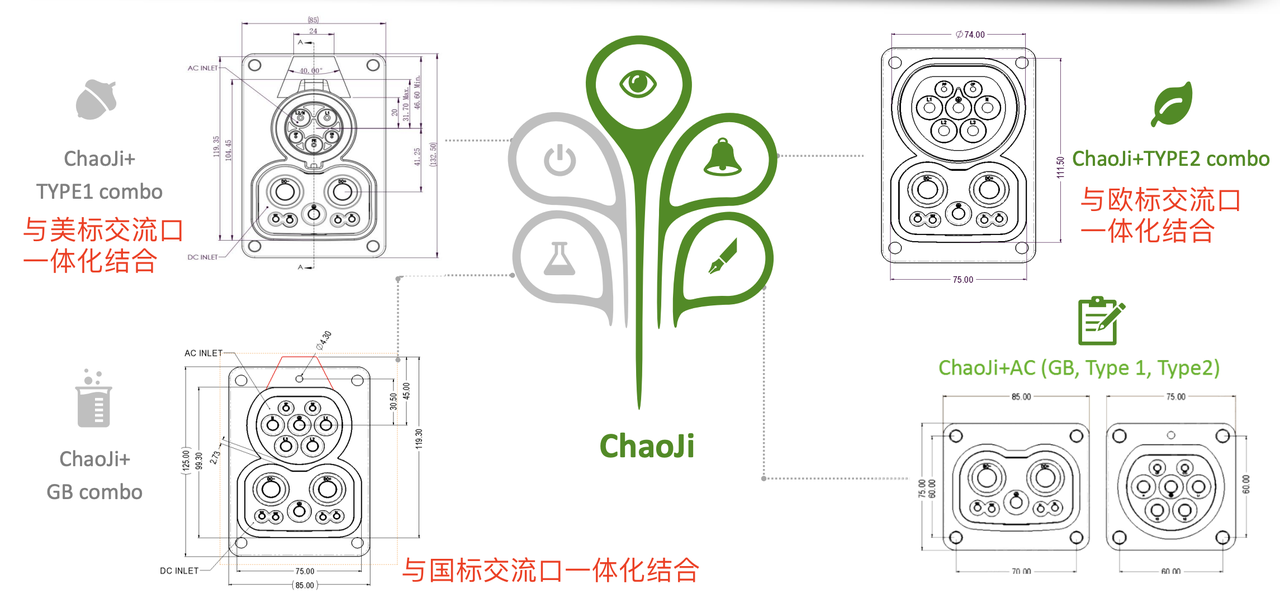 # 2015 + Standard?
# 2015 + Standard?
The biggest advantage of 2015+ after this upgrade is that the connector is similar to the original physical size, which can be directly interconnected. However, the disadvantage is that because it needs to be compatible with existing cars and charging piles, the mechanical structure still does not meet IPXXB standards. As a result, 2015+ still cannot enter the international charging standard, and our domestically produced cars cannot be directly exported.
Some people may say that it’s okay to design according to the local standards. After all, there are only three charging systems internationally, and we can just follow their lead. Some car manufacturers even say that they have no intention to export their products.
However, this will only make foreigners feel that China is not meticulous in setting standards, does not value safety, and does not have a strong willingness to integrate into international standards.
Additionally, whether 2015+ can perfectly match the old 2015 national standard remains an issue. In actual use, compatibility between new cars and old charging piles, or old cars and new charging piles still may have problems. If there is a charging malfunction, due to the identical new and old interfaces, car owners may not be able to determine the problem and customer service will not be able to confirm; thus leading to a confusing phenomenon of indeterminacy.
The drawback of the ChaoJi standard is that although it surpasses 2015+ on a technical level, it requires a new design. New ChaoJi cars need an adapter to use 2015 charging piles. The new charging piles need to be equipped with two charging ports to serve new and old car models at the same time. This results in additional costs for promoting the conversion to ChaoJi, which evidently not many people are willing to undertake for vehicles and charging piles that are already in use.
This has also become the biggest obstacle to the adoption of the ChaoJi standard.
Two paths running parallel
Standard development is a very rigorous and lengthy process, divided into several stages in China: Preliminary research, project approval, drafting, soliciting opinions, review, approval, publication, re-examination and cancellation.
Moreover, because charging standards involve both cars and charging piles, the responsible charging system GB/T 18487.1, the connector responsible 20234 series, and the communication responsible 27930 series standards constitute a complete charging standard, guiding the industry towards implementation.
However, because of historical reasons, this charging standard has been split in half, with two separate entities responsible for each half, the National Technical Committee on Auto Standardization (NTCAS) and China Electric Power Technology Standardization Committee (CEPTSC).
In the current 2015 national standard, the charging system and communication protocol standard GB/T 18487.1 and 27930 are under the responsibility of CEPTSC. The vehicle terminal and connector-related GB/T 20234.1/.2/.3 standards are under the responsibility of NTCAS.
This is like launching a nuclear missile, with two entities holding one key each, and with both keys starting the missile launch.According to the public information released on the National Standard Public Information Service Platform, the ChaoJi standard, under the responsibility of China Electricity Council, took a long time to be drafted. It has entered the solicitation phase in GB/T 18487.1, 20234.4, and 27930 and has formed a complete set of charging systems.

Notably, GB/T 18487.1 and 27930 of the ChaoJi standard were already included in the revision plan in January 2020 and have gone through the second round of soliciting opinions. In the vehicle and connector parts, China Electricity Council has also directly added DC Interface Standard GB/T 20234.4 to the ChaoJi standard.
On the other hand, only GB/T 20234.1 and .3 of the 2015+ electric vehicle charging standard of SAC (Standardization Administration of China) Committee have just been released for soliciting opinions at the end of April. To form a complete set of charging standards, it is necessary to draft and match GB/T 18487 and 27930 of ChaoJi standard.

However, the contradiction is that China Electricity Council has submitted and entered the solicitation phase for GB/T 18487 and 27930 standards. It remains unknown how the two units will reach a consensus and jointly promote them.
According to an EV charging expert who is part of the standard drafting team, he used to be invited to internal discussions regarding the 2015+ standard, but he has not been called for recent discussions.
It seems that the two standard drafting units have developed a rift.
Currently, it requires both sides to upgrade their own keys and form a pair with each other to work together. However, now both sides want to develop their own systems to replace the other’s key, thereby replacing the old 2015 national standard.
In addition, there is another very important issue, which is the implementation time of the standards. These three standards are interdependent and must be implemented at the same time. Implementing only one or two of them is not sufficient. Referring to the release of the 2015 national standards, the implementation time of all three standards was January 1, 2016.
According to the standard drafting process, after soliciting opinions, the next step is the review stage of the SAC Committee. Once the review is passed, the standards can be approved and released.
It has been more than 2 years since China Electricity Council submitted GB/T 18487.1 and 27930. For some unknown reason, these standards have not yet entered the review stage and have exceeded the project cycle.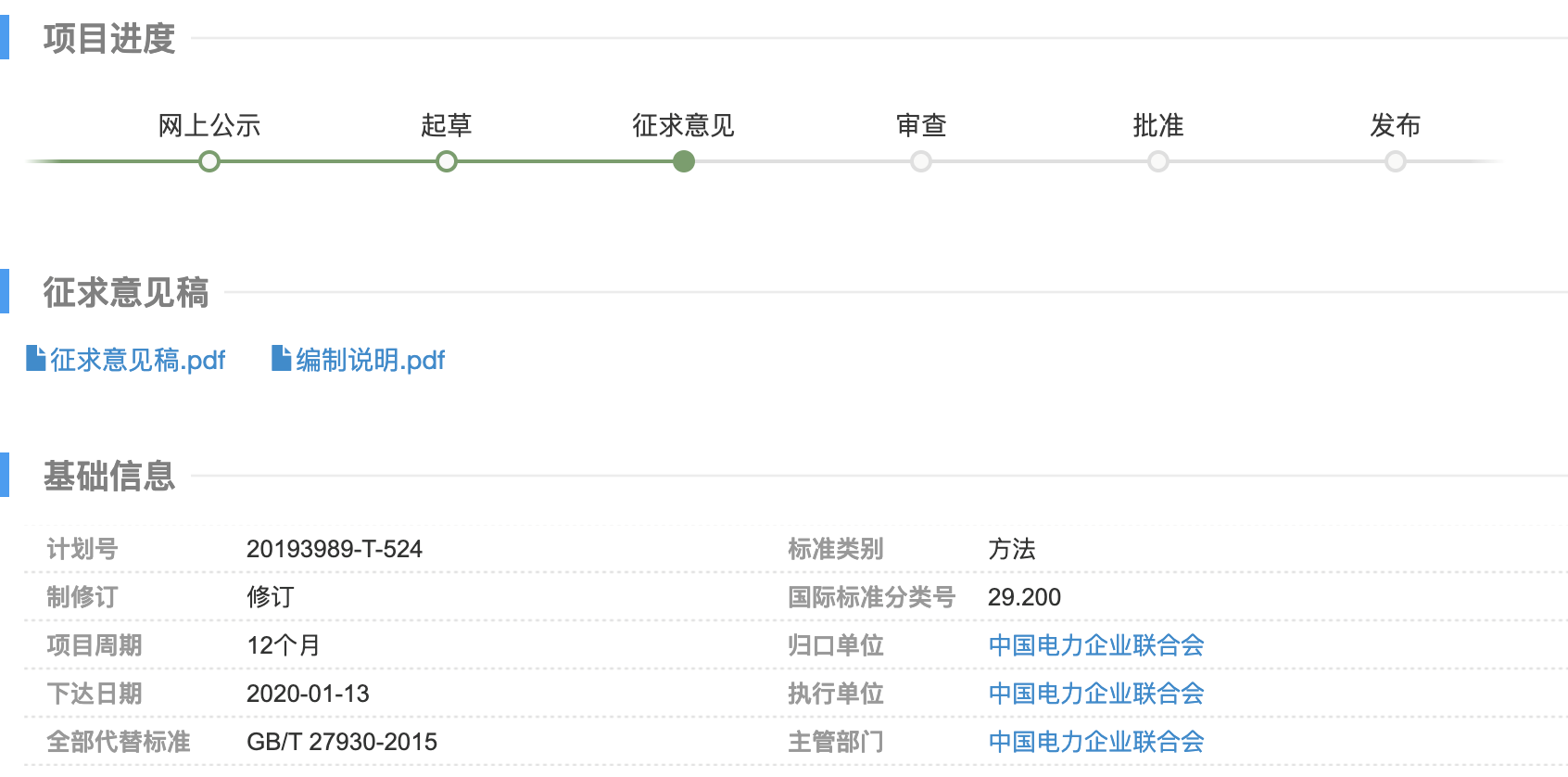
Who will become the mainstream?
“When gods fight, ordinary people suffer.“
This is a quote from an insider in the chain.
The delay in the release of charging standards has disrupted the R&D rhythm of many enterprises. Some have been forced to choose ChaoJi standards and jointly develop with 2015+ standards. Some have chosen 2015+ directly because they see the trend as wrong. Some have already prepared new car models with ChaoJi interfaces but now have to turn around and research 2015+.
In communication with nearly 10 insiders in host factories, operators, power grids, connectors and other industries, everyone expressed recognition of the technical advancement, safety, and systematization of the ChaoJi standard. Many companies also expressed support in repeated standard discussion meetings, but most people feel that the possibility of promoting 2015+ is greater due to the pressure of reality.
The pressure of reality mainly comes from several parts:
- Comparing the drafting units and the forces behind them. In industrial development, host factories are the absolute power that drives the downstream industrial chain, while most members behind the Automobile Standardization Committee (ASC) are host factories. The China Electricity Council (CEC) is mostly on the side of power grids and operators and is obviously at a disadvantage in absolute power, with limited influence on the drafting of standards.
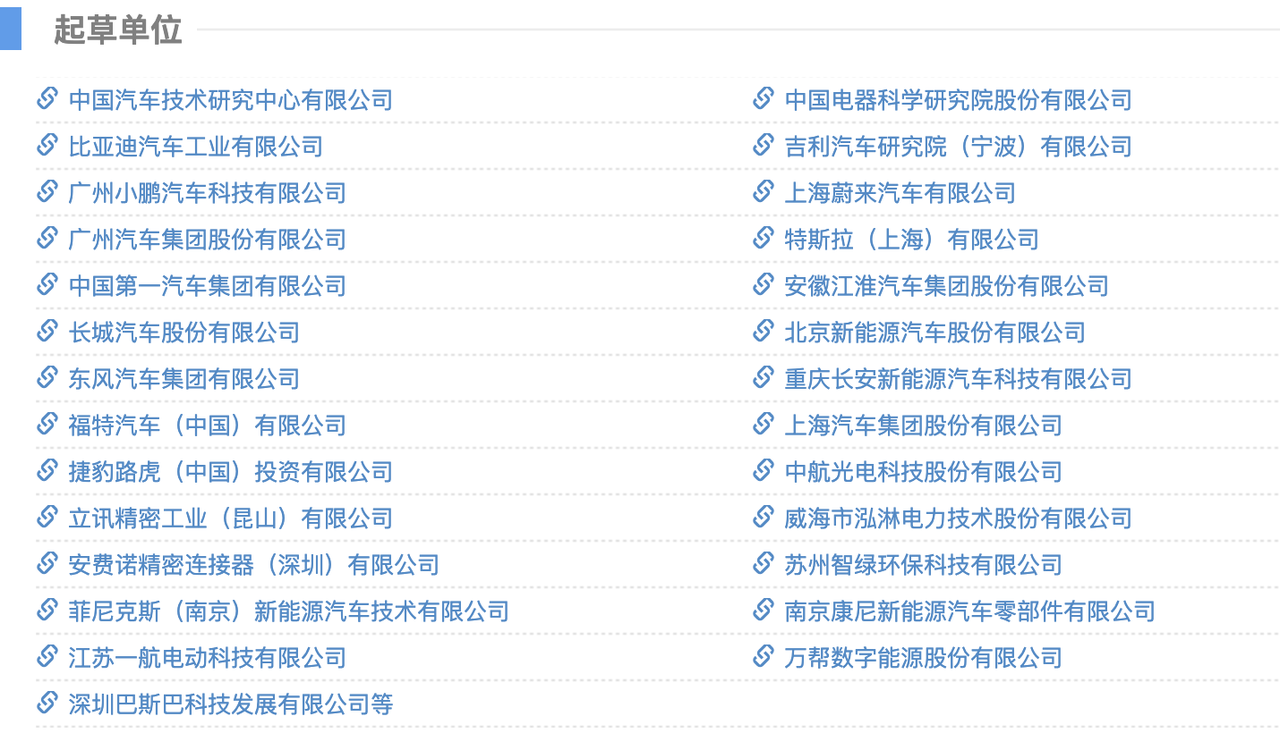
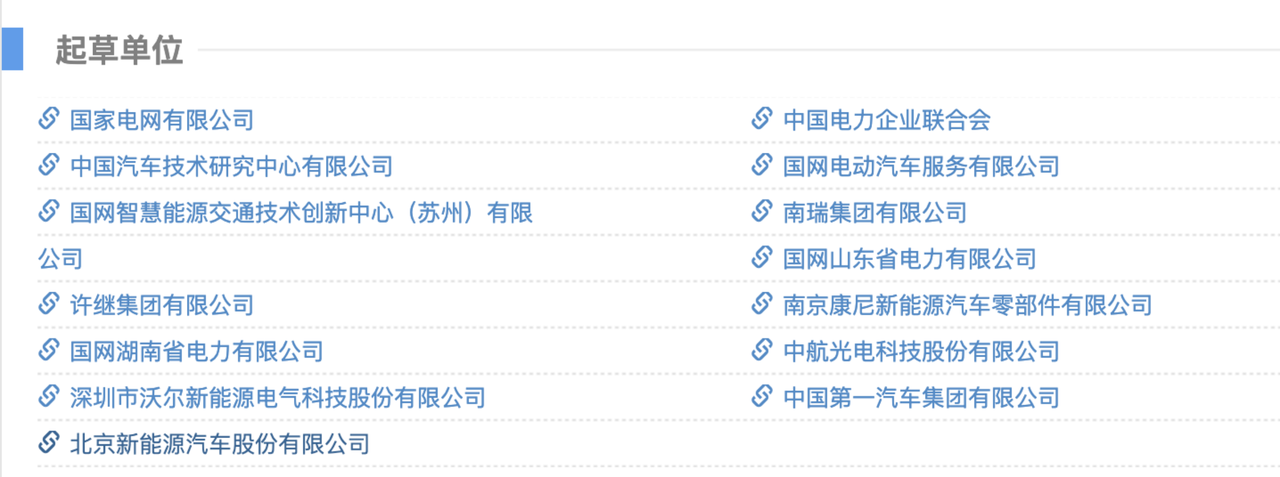
-
The power of announcement for new car models. The governing unit of the ASC is the Ministry of Industry and Information Technology (MIIT), which holds the power of life and death over the announcement of new cars. Without the announcement, a new car cannot be sold. Host factories can directly announce their cars according to the existing 20234.1 and .3 standards of 2015+. However, if MIIT does not include the 20234.4 ChaoJi interface of CEC in the announcement, host factories will not dare to choose the ChaoJi standard.3. Consider the compatibility of existing vehicles and charging piles, user experience, and saving development and investment costs. Because the new 2015+ connector can directly support the old standard, users can seamlessly switch without additional adapter costs, resulting in no change in user experience. However, according to a staff member of a certain automaker, although there seems to be no change in hardware, the electronic design behind both the vehicle and charging pile need to be redesigned and validated, which does not save a lot compared to adopting the new ChaoJi standard.
-
Inertia in internal corporate R&D and lack of attention and professionalism from senior management. In many corporations, such as major automakers, there is a large R&D inertia, which makes it difficult to change existing solutions and supply chains. At the same time, small systems like charging are not given enough attention by senior management in major automakers, and they often lack professionalism. Therefore, many department heads or directors of major automakers just make the decision directly, but their understanding of the standards is not deep enough.
The ChaoJi standard has been widely participated in by the industry from the beginning, especially with support from Japan. Industry participation became more active, but with the delayed release, as well as the push of the 2015+ standard by auto standards committees, the attitudes and enthusiasm of everyone have shifted.
So there will be three choices:
- Promote 2015+ to replace the old national standard.
- Promote ChaoJi to replace the old national standard.
- Coexistence of 2015+ and ChaoJi, both of which can be announced and the market can choose which to use.
If the first or second choice is made, it will be the smallest resource consumption for the industry, but replacing it is not as easy to implement as the old 2015 national standard.
In 2015, the sales volume of new energy vehicles throughout the year was 379,000, and there were only tens of thousands of public charging facilities nationwide. Now, with nearly tens of millions of existing vehicles and over a million existing charging piles, even if standards are implemented, it will take a long time to upgrade and transform, as well as continuous investment in new vehicles and piles to gradually reverse the penetration ratio of the old and new standards.
If the third choice is made, the industry will inevitably be in a chaotic situation for the first few years, with both old and new 2015 national standards and ChaoJi standards for vehicles and charging piles coexisting in the market.
The best situation is for the industry to go through 3-5 years of market-driven selection, with most companies agreeing on a certain development path and gradually replacing it.
“This is the situation we least want to see. If the standards coexist, would we have to bring two systems in new car R&D, or let users choose one? This will cause huge confusion and costs. We still hope that the regulatory authority can come up with one standard, no matter which one it is,” said a charging personnel from a certain international automaker. When he said this, he no longer cares which standard is safer or more systematic.Even if coexistence is chosen, many industry insiders still believe that the market will most likely choose 2015+. However, at least the ChaoJi standard has been recognized and the spark has been preserved. Who knows, there might be a turning point.
On the other hand, another international automaker’s charging personnel stated that if they give up the ChaoJi standard, they would lose the opportunity to make the domestic charging standard an international standard, and it would also make it more difficult for domestic vehicles to enter the global market.
Once the discussion reaches this stage, the charging standard is no longer a simple technical competition, but a mix of regulatory agencies, market forces, input-output ratios, etc. It is more important to consider the smooth transition of the existing and incremental markets.
With the rapid development of technology, from the perspective of the old 2015 domestic standard, its historical mission has been completed and it requires rebirth.
Therefore, the new energy vehicles and charging industry in China need to make a difficult decision.
This article is a translation by ChatGPT of a Chinese report from 42HOW. If you have any questions about it, please email bd@42how.com.
